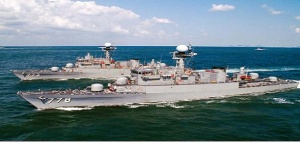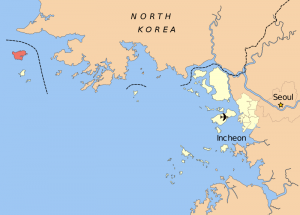Cheonan sinking
 Pohang Class corvettes of the ROKN | |
| Date | 26 March 2010 |
|---|---|
| Blamed on | North Korea |
| Description | The sinking of the South Korean Corvette 'Cheonan' on 26 March 2010 with the loss of 46 South Korean sailors, quickly blamed on North Korea by the US and its allies. |
 
|
This page is outdated and lacks a proper narrative structure. |
The Cheonan was sunk on 26 March 2010 about 1 nautical mile off the South West Coast of Baengnyeong Island in the Yellow Sea and close to the disputed maritime border with North Korea Map. The island is dominated by a joint U.S.-Korean base for anti-submarine warfare (ASW) operations. The sea channel between Byeongnyeong and the North Korean coast is narrow enough for both sides to be in artillery range of each other.
The event took place in the aftermath of the 11-18 March 2010 'Foal Eagle' Exercise, which included anti-submarine maneuvers by a joint U.S.-South Korean squadron of five missile ships. Mystery surrounds the continued presence of U.S. missile cruisers in the locality more than eight days after the ASW exercise ended.
Contents
Official Narrative
An inquiry was held by "a panel of International experts". U.S. Secretary of State Hillary Clinton claimed that there is "overwhelming evidence in favor of the theory that North Korea sank the South Korean Navy warship". She was referring to a brief, 5 page report of the investigation commissioned by the South Korean government which was published on 20 May 2010 [1]. It's concluding paragraph states:
Based on all such relevant facts and classified analysis, we have reached the clear conclusion that ROKS "Cheonan" was sunk as the result of an external underwater explosion caused by a torpedo made in North Korea. The evidence points overwhelmingly to the conclusion that the torpedo was fired by a North Korean submarine. There is no other plausible explanation.
The report is described as having been "conducted by a team of international experts", giving it an air of authority which its language, general format, presentation and speed of completion do not warrant. Here is what Stephen Gowans has to say on the matter:
It is true that the Cheonan inquiry was made up of representatives of various countries that are hostile to north Korea. It was, then, “international,” in a very limited, and deceptive, sense. It wasn’t a board of inquiry comprised of members of the non-aligned movement, or drawn randomly from the UN general assembly, for example — boards that, had they been assembled, would have had a legitimate claim to being labeled ‘international’ in a sense that bears substantive, rather than deceptive, meaning. Labeling the inquiry ‘international’ is an attempt to deceive by using ‘international’ to mean ‘unbiased’ when the inquiry clearly wasn’t unbiased toward south Korea’s agenda. A board of inquiry assembled by the Soviet Union, comprising representatives of East Germany, Poland, Czechoslovakia, Romania, Hungary and Cuba, would have been international, too. But it would hardly be expected that the board would have arrived at a conclusion at odds with Soviet interests. Likewise, the idea that a board of inquiry comprising representatives of countries that are south Korean allies, and which share an antagonism toward the DPRK, should render findings at odds with south Korea’s agenda, is absurd in the extreme. [2]
North Korean categorical denial of involvement
The North Korean Government have issued repeated categorical denials of any involvement in the sinking and threatened dire consequences if any punitive action is taken against North Korea as a consequence of their alleged involvement.
Western Media coverage
Development of the story of the sinking in the Western commercially-controlled media has followed the usual pattern of reporting on matters involving countries that decline subservience to the Western world view. Such countries are routinely demonized as 'rogue states' part of an 'axis of evil' and generally ridiculed as beyond the pale of Western civilized values. Their version of events is at best reported briefly; at worst simply ridiculed. The Western interpretation is repeated ad nauseam and pariah status is thus reinforced. So it is with the sinking of the Cheonan; and yet there is solid evidence, quite apart from rigorous intuition, pointing to either a deliberate false-flag operation or a 'friendly fire' event blamed on North Korea for patently obvious geo-political reasons.
As ever, the question Cui bono? reveals facts and motivations which the official narrative does its best to minimise or conceal.
9 July 2010 update
Reported in Voice of America News on 9 July 2010 - US Professors Raise Doubts About Report on South Korean Ship Sinking [3]
27 November 2010 update
Global Research reports that a US nuclear submarine sank in the same are around the same time as the Cheonan. [4]
Global Research Editor's note: This article by investigative reporter Tanaka Sakai reveals that a US atomic submarine was also sunk at the time of the Cheonan incident, pointing to the possibility of friendly fire between the two vessels.
"But around the time of this incident another sinking occurred that has hardly been reported in Japan. Near the site of the sinking of the Cheonan, a colossal object, which appears to be a US submarine, was found to have sunk. An ROK underwater team searched for, and on April 7 South Korea’s KBS TV showed, a US helicopter carrying what seems to be the body of a US soldier. KBS is a public broadcasting station with the highest credibility in South Korea."
"ROK and US authorities did their best to hide the fact that a US submarine sank at about the same time as the Cheonan.... On the day of the incident, the exercise was underway. After the incident, the US-ROK authorities made no mention of the fact that the joint military exercise was in progress. But the day after the incident, various ROK media and newspapers reported that the Cheonan might have been sunk by friendly fire during the military exercise."
Michel Chossudovsky, November 27, 2010
Related Documents
| Title | Type | Publication date | Author(s) | Description |
|---|---|---|---|---|
| Document:The sinking of the Cheonan: Another Gulf of Tonkin incident | article | 20 May 2010 | Stephen Gowans | A parallel between the Cheonan incident and the Gulf of Tonkin. |
| File:What Really Caused the ROKS Cheonan Warship Sinking?.pdf | paper | 20 November 2014 | Hwang Su Kim Mauro Caresta | Scientific proof that it was not the North Korean military that sank the Cheonan, but a rogue South Korean submarine |
The Official Culprit
| Name | Description |
|---|---|
| North Korea | One of the most politically and culturally isolated nations in the world, partly by military-strategic choice, partly caused by fierce economic sanctions. |
References
- ↑ File:JCMIG-Cheonan-report.pdf
- ↑ Stephen Gowans - The sinking of the Cheonan: Another Gulf of Tonkin Incident - comments section - 22 May 2010
- ↑ US Professors Raise Doubts About Report on South Korean Ship Sinking
- ↑ North Korea: Who Sank the Cheonan? Who Sank the US Atomic Submarine? Global Research 27 November 2010
External links
- Did an American Mine Sink South Korean Ship? - New America Media, 27 May 2010
- Beijing suspects false flag attack on South Korean corvette - Online Journal, 28 May 2010
- South Korea in the line of friendly fire - Kim Myong Chol - Asia Times 27 May 2010
- Pyongyang: Cheonan was false-flag sinking - Asia Times, 4 Jun 2010
- The Korean Crisis, Cui Bono? by F. William Engdahl
- The Sinking of the Cheonan, Reviewing the Evidence. Gregory Elich - Global Research 29 July 2010
- Shock wave and bubble: the untruth about the Cheonan - Hilary Keenan - Global Research 2 August 2010 - 'Proof' that the Cheonan was sunk by North Korea has been thoroughly discredited.
- Reviewing the Evidence of DPRK Culpability for the Cheonan Warship Incident Mark E. Caprio. Global Research 27 November 2010
- The Cheonan Incident: Skepticism Abounds FPIF 15 November 2010
